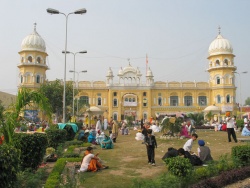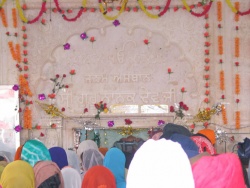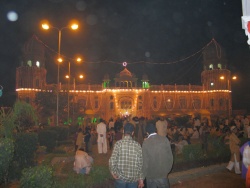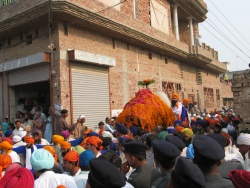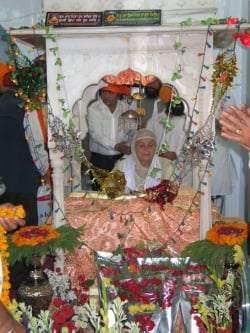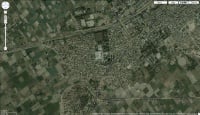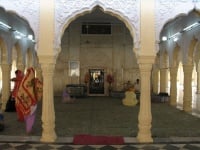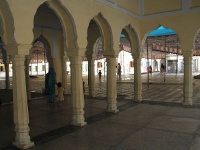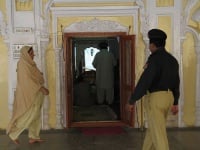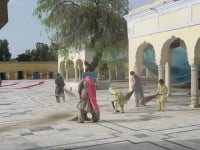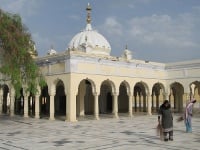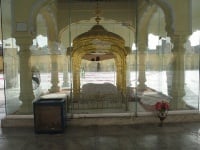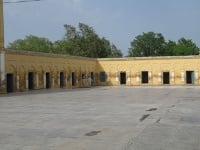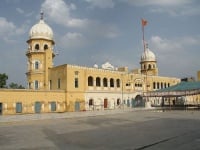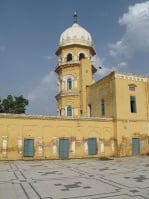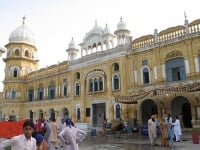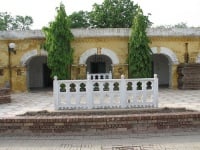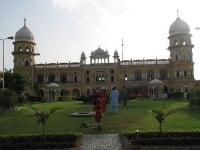Nankana Sahib
Nankana Sahib is named after Guru Nanak Dev Ji (1469-1539), the founder of the Sikh faith. Guru Nanak Dev Ji was born here on Baisakh sudi 3, 1526 Bk/ 15 April, 1469. The Nankana town is part of the Nankana Sahib District in the Punjab province of Pakistan. This district is adjacent to the Sheikhupura district. The Nankana Saahib District was part of the Sheikhpura District but in 2005, the district was split off to form the New Nankana Saahib District.
The old name of town was Talvandi Rai Bhoe Ki or "Talvandi of Rai Bhoe", a Muslim Rajput of the Bhatti clan and a retainer of the Delhi rulers of the early fifteenth century. His descendant, Rai Bular, the chief of Talvandi, was a contemporary of Guru Nanak. The town has nine gurdwaras including the Gurdwara Janam Asthan which marks the birth place of Guru Nanak Dev.
Early life
The first 15 or 16 years of Guru Nanak's life were spent at Talvandi. Later, he shifted to Sultanpur Lodhi, in present day Kapurthala district of the Punjab, where his sister Bibi Nanaki lived. From there he set out on his long preaching odysseys, visiting his parents at Talvandi only now and then, his last visit to his native place being in 1510. Several shrines in the town, raised long after his death, mark the places where he was born, where he played with other children, where he studied and where he tended his father's cattle.
The state government has ambitious plans for the area and has prepared plans to develop Nankana Sahib with various projects including a rest house for Sikh pilgrims, a new hotel, a shopping mall, a housing scheme, a world class university, modern schools, a modern hospital and a road-link to the Lahore-Faisalabad dual-carriage way. A trans-national bus link is proposed that would operate between Nankana Sahib and Amritsar of Punjab in India. The town is located about 75 kilometres west-southwest of Lahore and about 40 km south-west of Sheikhpura.
Gurdwaras in the Town Honoring Guru Nanak
- Commemorating the birthplace of Guru Nanak it is the premier shrine at Nankana Sahib. A room first built here by his son, Baba Lakhmi Das (1497-1555), more probably by his grandson, Baba Dharam Chand (1523-1618), was known as Kalu ka Kotha, lit. house of (Mahita) Kalu, father of Guru Nanak. Later it came to be known as Nanakayan, lit. Home of (Guru) Nanak. Maharaja Ranjit Singh (1780-1839), at the instance of Akali Phula Singh and Baba Sahib Singh Bedi, constructed the present building, a domed square sanctum with a pavilion in front standing on a spacious, raised platform, and made an endowment of about 20,000 acres of land for the maintenance of Guru ka Langar. The management remained with Udasi priests until the Shiromani Gurdwara Parbandhak Committee took it over after the gruesome events of 20 February 1921. With the partition of the Indian subcontinent in 1947 and the migration of Sikh population from Pakistan, the management of all Sikh gurudwaras in the newly created State, including those at Nankana Sahib, passed to the Waqf Board. The Government of Pakistan later allowed 15 Sikhs to stay in Nankana Sahib to perform the daily services in the shrines. In 1968 the number was reduced to 5. Now only a Granthi or scriptural reader and a few Sindhi Sikhs stay at Gurdwara Janam Asthan. Batches of pilgrims from India are occasionally allowed to visit with special permission from the Pakistan Government.
GURDWARA PATTI SAHIB
- This Gurdwara with in the town, marks the place where stood Guru Nanak's school. The child Nanak, a quick learner, soon became proficient in Hindi, Persian, arithmetic and accounting. The Gurdwara is a small square room with a fluted lotus dome above it and ornate masonry work on the exterior. It is also called Gurdwara Maulawi Patti.
GURDWARA BAL LILA
- About 300 metres southeast of Gurdwara Janam Asthan, marks the field where Guru Nanak used to play in the company of other children. Guru Hargobind during his visit to the town is said to have marked the site. Diwan Kaura Mall, a Hindu noble (d. 1752), after his victory over Multan with the assistance of the Sikhs in 1748, built this Gurdwara and brick lined two sides of the nearby tank originally got dug by Rai Bular. Maharaja Ranjit Singh had the building renovated and the tank enlarged and properly lined. Of the land donated by him, about 3,000 acres were allotted to Gurdwara Bal Lila. After the 1921 tragedy at Gurdwara Janam Asthan, the custodian mahants of this shrine voluntarily handed it over to the Shiromani Gurdwara Parbandhak Committee in exchange for suitable maintenance allowance for their families. The Gurdwara was reconstructed during the 1930's and 1940's under the supervision of Sant Gurmukh Singh Sevavale (1849-1947). The new building on the bank of the adjoining sarovans a multistoreyed domed edifice.
GURDWARA KIARA SAHIB
- About two kilometres to the east of Gurdwara Bal Lila, commemorates an event connected with the early years of Guru Nanak. While tending his father's herd of cattle, it was common for him to let the animals roam freely while he himself sat engrossed in meditation. Once a peasant complained to Rai Bular that Nanak's cattle had damaged the crop in his field, but when the field was inspected, no damage was discovered. The people considered it a miracle and that particular field came to be reverently called Kiara (lit. field or plot) Sahib. A shrine was raised here which was reconstructed by Sant Gurmukh Singh Sevavale during the decade preceding the partition of 1947. The new building comprises a square, domed sanctum and a circumambulatory verandah built on a raised plinth.
GURDWARA MALJI SAHIB
- This Gurdwara stands about one and a half kilometres east of Gurdwara Janam Asthan. The Janam Sdkhis record an anecdote stating how Guru Nanak was one day sleeping on the ground under a mdl tree, also called van (Quercus incana) and how in the afternoon as Rai Bular and his men were passing by they noticed that while all shadows had lengthened and shifted eastward, the shade of that particular tree stood still over the sleeping Nanak. The Bald Janam Sdkhi has a slightly different version saying that as the shadow of the tree shifted, a cobra was seen spreading its hood over Guru Nanak's face protecting it from the sun. Rai Bular, impressed by the miracle bacame a devotee. The Gurdwara on this site was first built by Diwan Kaura Mall and renovated during the time of Maharaja Ranjit Singh.
GURDWARA TAMBU SAHIB
- About 300 metres east of Gurdwara Janam Asthan, was raised by a Nihang Sikh about the middle of the nineteenth century. It stands near a huge van tree spreading its branches like a tent (tambu, in Punjabi). Tradition recounts how Mahita Kalu once gave his son, Guru Nanak, some money for buying merchandise from Chuharkana, a nearby market town. Guru Nanak, however, spent the money feeding a group of hungry sadhus. Coming back emptyhanded and apprehensive of his father's wrath, he is said to have hid himself under the tentlike tree by the side of which now stands Gurdwara Tambu Sahib.
GURDWARA CHHATI PATSHAHI
- About 200 metres east of Gurdwara Janam Asthan, is dedicated to Guru Hargobind (the 6th Nanak) who visited Nankana Sahib in 1620-21. This, too, was built and managed by Nihang Sikhs and came under the control of the Shiromani Gurdwara Parbandhak Committee in 1921.
Guru Arjan Dev the fifth Guru and his son Guru Hargobind the sixth Guru also visited this town.
Links to further Articles on these historical Gurdwaras:
From a Pakistani newspaper editorial:
- In 1994, the foundation stone of Nankana Sahib Foundation was laid by Rai Bashir Ahmad Khan Bhatti, a member of the National Assembly and chairman of the Standing Committee on Education. Mr Bhatti is the oldest living descendent of Chaudhry Rai Bular Bhatti, a contemporary of Guru Nanak, who recognised that the Guru was a divine soul. Over the last five hundred years, the Bhatti family has donated almost 11,000 acres of its land to the Sikh religious shrines in and around Nankana Sahib. The 1994 foundation, built over 10 acres of land, was donated by Chaudhry Rai Sarwar Bhatti, also a direct descendent of Rai Bular Bhatti.
- The entire Nankana Sahib Estate consists of 16,962 acres. Most of it is leased to the farmers and residents of Nankana Sahib. Almost all the houses in Nankana Sahib are built on this property. The Nankana Sahib Estate is the property of the Nankana Sahib Gurudwara (Gurudwara Janam Asthan).
See also
External links
Gallery
- Picture Gallery
References
- AllAboutSikhs.com
- Punjabilok.com
- Sgpc.net
- Narotam, Tara Singh, Sri Guru Tirath Sangrahi. Kankhal, 1975
- Thakar Singh, Giani, Sri Gurduare Darshan. Amritsar, 1923
- Khan Mohammad Waliullah Khan, Sikh Shrines in West Pakistan. Karachi, 1962
- Sahi. J. S., Sikh Shrines in India and Abroad. Faridabad, 1978
9. Nanakana Sahib - Narain Singh Tract No. 412
10. ਨਨਕਾਣਾ ਸਾਹਿਬ ਦਰਸ਼ਨ - ਤਾਂਘ ਤੇ ਪਰਯਤਨ, ਗੁਰੂ ਨਾਨਕ ਦੇਵ ਮਿਸ਼ਨ ਸੀਰੀਜ਼ ਨੂੰ ੩੫੬
12. ਪਾਕਸਤਾਨ ਅੰਦਰ ਰਹੇ ਗੁਰਦੁਆਰੇ, ਗੁਰੂ ਨਾਨਕ ਦੇਵ ਮਿਸ਼ਨ ਲੜੀ ਨੂੰ ੧੩੮
13. ਨਨਕਾਣਾ ਸਾਹਿਬ ਦਰਸ਼ਨ - ਤਾਂਘ ਤੇ ਪਰਯਤਨ, ਗੁਰੂ ਨਾਨਕ ਦੇਵ ਮਿਸ਼ਨ ਸੀਰੀਜ਼ ਨੂੰ ੧੭੫
14. ਗੁਰਦੁਆਰਾ ਜਨਮ ਅਸਥਾਨ: ਨਨਕਾਣਾ ਸਾਹਿਬ ਦਾ ਹਿਰਦੇ ਵੇਧਕ ਸਾਕਾ - ਨਰੈਣ ਸਿੰਘ, ਗੁਰੂ ਨਾਨਕ ਮਿਸ਼ਨ ਸੀਰੀਸ਼ ਨੂੰ ੪੧੩
15. ਸ੍ਰੀ ਨਨਕਾਣਾ ਸਾਹਿਬ ਦੇ ਸ਼ਹੀਦਾਂ ਨੂੰ ਸ਼ਰਧਾਂਜਲੀ, ਗੁਰੂ ਨਾਨਕ ਦੇਵ ਮਿਸ਼ਨ ਸੀਰੀਜ਼ ਨੂੰ ੧੭੯
17. ਭਰੋਸੇ ਦਾ ਭਾਂਬੜ - ਬਾਲ ਸ਼ਹੀਦ ਦਰਬਾਰਾ ਸਿੰਘ - ਪ੍ਰੋਫ਼ੈਸਰ ਸ਼ੇਰ ਸਿੰਘ ਸ਼ੇਰ, ਗੁਰੂ ਨਾਨਕ ਦੇਵ ਮਿਸ਼ਨ ਸੀਰੀਜ਼ ੩੦੯
